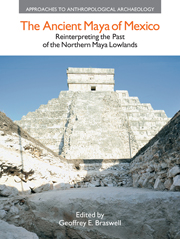Book contents
- Frontmatter
- Dedication
- Contents
- Contributors
- List of Figures
- List of Tables
- 1 The Ancient Maya of Mexico: Reinterpreting the Past of the Northern Maya Lowlands
- Part I THE PRECLASSIC PERIOD
- Part II THE EARLY AND LATE CLASSIC PERIODS
- Part III THE TERMINAL CLASSIC AND EARLY POSTCLASSIC PERIODS
- 8 The Nunnery Quadrangle of Uxmal
- 9 In the Shadow of the Pyramid: Excavations of the Great Platform of Chichen Itza
- 10 Divide and Rule: Interpreting Site Perimeter Walls in the Northern Maya Lowlands and Beyond
- Part IV THE LATE POSTCLASSIC TO HISTORICAL PERIODS
- Part V CONCLUSIONS
- Index
8 - The Nunnery Quadrangle of Uxmal
from Part III - THE TERMINAL CLASSIC AND EARLY POSTCLASSIC PERIODS
- Frontmatter
- Dedication
- Contents
- Contributors
- List of Figures
- List of Tables
- 1 The Ancient Maya of Mexico: Reinterpreting the Past of the Northern Maya Lowlands
- Part I THE PRECLASSIC PERIOD
- Part II THE EARLY AND LATE CLASSIC PERIODS
- Part III THE TERMINAL CLASSIC AND EARLY POSTCLASSIC PERIODS
- 8 The Nunnery Quadrangle of Uxmal
- 9 In the Shadow of the Pyramid: Excavations of the Great Platform of Chichen Itza
- 10 Divide and Rule: Interpreting Site Perimeter Walls in the Northern Maya Lowlands and Beyond
- Part IV THE LATE POSTCLASSIC TO HISTORICAL PERIODS
- Part V CONCLUSIONS
- Index
Summary
Abstract
This chapter considers the function of the Nunnery Quadrangle of Uxmal, one of the most important examples of the Terminal Classic Puuc architectural style. Uxmal has several quadrangles, but the particular interest of the Nunnery is the manner in which a local architectural form, and most probably the social institutions that it housed, were modified by the incorporation of “Mexican” or “Toltec” iconography and architectural traits in the late ninth or early tenth centuries. These traits mark the emergence of Uxmal as another of the Epiclassic Tollans, as was Chichen Itza in eastern Yucatan.
The central argument of this chapter is that the Nunnery Quadrangle was the meeting place of the court of Uxmal and that each of its wings was dedicated to one of the four “estates” directing its governance. The four “estates” represented by the Nunnery Quadrangle are the king to the north, a priestly or noble council to the west, the military to the east, and the secondary clients subject to or allied with Uxmal to the south. The Nunnery, therefore, was the place where these four “estates” met to debate matters of state, make judgments, and carry out political rituals such as investiture. The prominence of the Nunnery and the elaboration of its architecture underscore the importance councils played in such polities, even though ultimate authority was vested in the king.
The proposition that the form and disposition of ancient buildings in some way reflect the ideologies of their occupants has been a fruitful one for the study of Maya urbanism (e.g., essays in Christie 2003; Evans and Pillsbury 2004; Houston 1998; Inomata and Houston 2001; Kowalski 1999).
- Type
- Chapter
- Information
- The Ancient Maya of MexicoReinterpreting the Past of the Northern Maya Lowlands, pp. 191 - 228Publisher: Acumen PublishingPrint publication year: 2012



